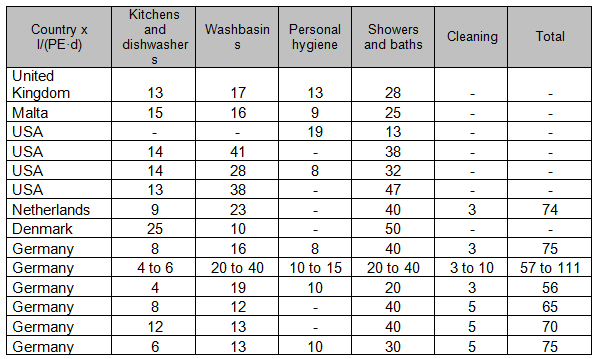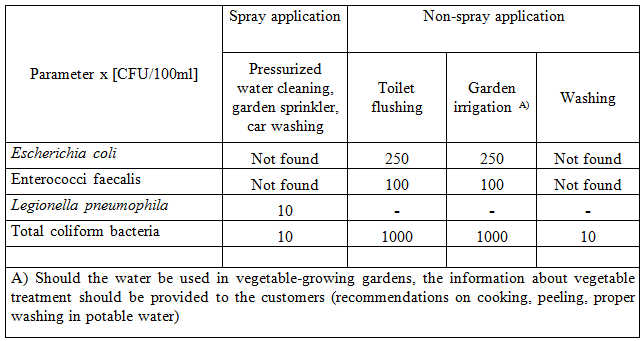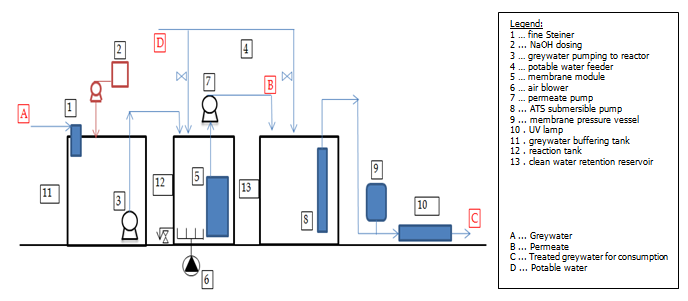Greywater and rainwater recovery in buildings
The main purpose of the greywater (used water from showers and bathrooms) recovery principally consists in the fact that these waters are negligibly polluted and their treatment is not too demanding; moreover, the waste heat of these waters can be successfully reused as well. The principal reason for water dividing is to separate greywater; compared to the local waste water treatment focused on separation of urine (yellow water) in order to reduce the nutrient content at discharge, see the large, completed projects DESAR or SWITCH. In the Czech Republic, the issue was dealt with in the TANDEM FT-TA3-012 project called Reduction of Nutrients and Waste Waters Discharged to Surface and Ground Water - Procedures and Management, carried out in co-operation with ASIO and Brno University of Technology. Reuse of greywater (white water) is often combined with rainwater recovery.
Another reason, why to concentrate on the issue, lies in the matter of prestige and in implementation of the building evaluation systems (certifications) related to their impact on environment. Certifications are carried out by various systems, e. g. LEED (Leadership in Energy and Environmental Design) or BREAM (Building Research Establishment Assessment Method). All evaluation systems should inspire the building designers to seek the savings not only in the heating and cooling systems, but also in the building water management. The designer should also be motivated to apply new, innovative methods or solutions focused on the water consumption reduction and thus reduce the quantity of the discharged waste waters. The popular Czech certification tool is the SBToolCZ. The water parameters are described in chapters E.08 Potable water consumption and E.12 Share of rainwater caught at plot.
Greywater Definition and Composition
Greywater has been named after the characteristic coloration and comprises sewage waste water discharged from washbasins, washing machines, baths, showers, sinks, etc. [2, 3]. Greywater does not contain excrements and urine. The treated and recovered greywater (mainly from baths) can be used as service water (so called white water) for toilet or urinal flushing and for garden irrigation.

Figure 1. Average water consumption in a household [2]
The chart of the figure 1 clearly shows that greywater production forms more than 50 % of the total waste water production in a household. Greywater quantity produced in the selected countries oscillates between 57 and 75 litres/PE d and is described in Table 1.
Table 1. Greywater production in selected European countries [7]

Increased greywater production has been noticed in hotels, swimming pools, saunas, restaurants and other similar facilities. The water consumption in a three-star hotel totals ca. 150 l/PE d, in a five-star hotel hen 1000 l/PE d. The greywater production mainly depends on the hotel facilities, e. g. availability of a wellness centre, sauna, swimming pool and kitchen cleaning [22]. Regarding the chemical composition (see Table 2), the proportion between COD and BOD 5 principally totals 4: 1, which indicates the higher content of degradable organic substances (in common municipal waste waters, the COD/BOD 5 usually totals 2 : 1). The adverse proportion mainly concerns the shower waters, containing soaps and shampoos. The pH of common municipal waste waters is usually 7 - 8. The greywater pH differs based on the process: washing machine waste water is basic (pH = 9 - 10), on the other hand, kitchen waste waters are more acid. Temperature of greywater discharged from baths, showers and washing machines ranges between 18 and 38 °C, as the water, used in the sanitary facilities, is mainly heated.
Table 2. BOD 5 , COD, pH values in greywater [7]

Alternative Resource to Potable Water
High-quality potable water should be used only in inevitable cases. The treated water can easily be used for toilet flushing or garden irrigation. The principle applies mainly in the areas with low-capacity potable water resources. Recycled water benefits [5]:
- Financial aspect - potable water price continuously increases,
- Reduction of nutrient discharge to environment - non-discharged water is not present in natural waters,
- Reduced carbon footprint - less of useless work.
The alternative water resources comprise:
- Recycled water supplied in a separate distribution pipeline, completely separated from potable water,
- Locally produced recycled water,
- Rainwater collected from roofs and impervious areas.
Greywater Treatment
Table 2 clearly shows that the greywater quantities vary principally based on the different life styles of population. The detailed analysis reveals that the shower and washing waters are least polluted compared to the kitchen greywater, largely polluted with organic residues and undissolved substances. Based on the above mentioned findings, greywater can be divided into water suitable and conditionally acceptable for recovery. Water from washbasins, baths and showers is fully acceptable, however, kitchen and dishwasher water is only conditionally acceptable [6]. Unfortunately, the detailed regulation related to the greywater recovery has not been available in the Czech Republic. For the time being, we can apply the foreign regulations, e. g. the British standard BS 8525-1 [2], comprising both technical requirements as well as the quality requirements placed on service (white) waters related to health risks, see Table 3.
Table 3. Informative values for bacteriological monitoring of service (white) water pursuant to BS 8525-1 and value differences at activities with or without aerosol development [2]

Greywater Recovery Equipment Proposal
The greywater treatment process can be divided into three parts: physical, physical-chemical and biological. At past, the natural methods were also applied, e. g. soil filter settlement and filtration. These methods are used even today, however, only at summer houses, etc. The larger buildings are equipped with the biological treatment systems, dissolved substance separation and other sanitary systems. At past, more extensive methods were used, e. g. activation with floating carrier and sand filtration. Today, most of manufacturers focus on the membrane bioreactors (MBR), see the diagram in Figure 2,due to their reasonable size (area saving up to 50 %). The bioreactors are sometimes fitted also with sanitary safety systems although the membranes provide the safety function as well. The figure depicts the bioreactor set including the necessary accumulation, membrane bioreactor and service water supply system to the service water pipelines.

Figure 2. Greywater treatment unit layout diagram [8]
Proposal for Greywater Recovery in a Spa Hotel - Case Study [4]
To get an idea about the extent of savings, one of the buildings, evaluated in the project, was selected as an example. The building comprises the spa hotel. The building is composed of 2 basement floors and 2 above-ground floors. The swimming pool and wellness centre are situated on 1st floor. The greywater recovery technical proposal contained several solutions, including various combinations of water collection and consumption. The elementary principle says that the greywater production should exceed the white water consumption by several per cent.
Table 4. Greywater collection

Table 5. White water supply

Balance equation: Q s – Q d = 6966 – 6828 = 138 l/day
Table 6. Differences in consumption with greywater recovery

In the particular spa hotel, up to half of the water production can be saved. Thinking about the water and sewer rates, the financial savings total more than 100,000 CZK.
Conclusion
In practice, there are many buildings that could favourable separate greywater and re-use it as service (white) water. The best economic indicators are logically achieved in buildings with higher water production/consumption (hotels, sports facilities, swimming pools, hospitals). Within the above mentioned scheme, many buildings were assessed both in relation to water recovery as well as to greywater waste heat recovery. The expenditure return rate ranged from 4 to 10 years. The costs for potential building modifications adversely impact the economic indicators at the existing buildings. However, when designing and constructing new buildings, there is no reason to waste the time. The new public buildings should be equipped with greywater separation as standard, either for greywater or waste heat recovery. The interesting point is that most of the old buildings in Prague contain the separate greywater pipelines due to the previous municipal regulations, even though the reason for greywater separation was little different compared to the recovery purposes.
Acknowledgement The article was created based on the support by the Greywater and Rainwater Recovery in Buildings project, integrated in the ALFA scheme of the Czech Republic Technology Agency no. TA01020311. ASIO, spol. s.r.o. and the Brno University of Technology participate in the project.
Ing. Adam Bartoník 1,2), Ing. Marek Holba, Ph.D.1,3) Ing. Karel Plotěný1) Ing. Jiří Palčík, Ph.D.1),
1) ASIO, spol. s r.o.
2) VŠCHT, ÚTVP
3) BÚ AV ČR
Bibliography
[1] Birks, R.; Colobourne, S.; Hobson, R. (2004): Microbiological water quality in a large in-building, water recycling facility. Wat. Sci. Tech., 50(2), pp. 165-172
[2] British Standard BS 8525-1:2010. Greywater systems – Part 1: Code of practice. UK: BSI, 2010.
[3] British Standard BS 8525-2:2010. Greywater systems – Part 2: Domestic greywater treatment equipment – Requirements and test methods. UK: BSI, 2010.
[4] Bogáňová, Ida. Greywater Application Options. Brno, 2012. 106 p., 6 p. of appendices. Diploma Thesis. Brno University of Technology, Faculty of Civil Engineering, Institute of Municipal Water Management.
[5] EUREAU Position Paper, Water re-use and other alternative resources at home: rainwater harvesting and greywater recycling for domestic purposes, Working Group Microbiological Quality, Eureau-Commission 1, July, 2011
[6] Palmquist, H., Hanaeus, J. (2005): Hazardous substances in separately collected grey- and blackwater from ordinary Swedish households. Sci. Tot. Env., 348, pp. 151-163.
[7] Plotěný K. Water division, white and grey waters – new findings and application options, Water Management Canapé seminars, ASIO, spol. s r.o. 2011, s 21-27. [8] Bartoník, A., Holba, M., Vrána, J., Ošlejšková, M., Plotěný, K. Greywater – options for application of greywater energy potential, Water Management 2/2012, s.60-64